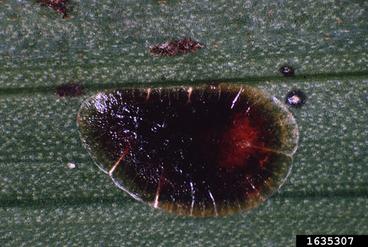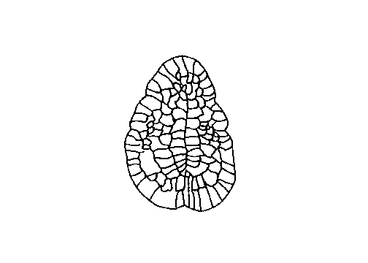SCIENTIFIC NAME: Eucalmnatus tessellatus (Signoret)
CLASS: Insecta
ORDER: Hemiptera
FAMILY: Coccidae


Description
Adult Females
Living adult females are flattened, reddish brown to dark brown, and 4-5 millimeters in length. The body is usually somewhat oval in outline, with the anterior end angulate and the posterior broadly rounded, but the shape may change due to position on the plant. When viewed under a hand lens or magnifying glass, the dorsal surface of the body has a checkered or cellular pattern, divided by a smooth longitudinal median ridge.
Crawlers
Tessellated scale crawlers are reddish brown, flat, elongate oval, and widest in the middle area of the body.
Nymphs
Settled nymphs are light golden in color, flat, oval, and adhering so closely to the leaf surfaces as to be nearly transparent. Males are unknown.
Biology
Host Plants
Tessellated scale occurs most commonly on palms and several species of Ficus, but it has been found on a wide variety of host plants.
Damage
Tessellated scale is primarily a leaf-infesting soft scale and a greenhouse pest. Heavy infestations weaken the plant but seldom kill it. Infestations are often of economic importance in commercial nurseries whenever pest management programs are neglected.
Life Cycle
One or two generations per year, and in greenhouses generations will overlap. Tessellated scale is parthenogenetic and ovoviviparous, giving birth to living young. Males are unknown.
Management Strategies
Biological Control
The parasitic wasp Metaphcus stanlei Compere is a natural enemy of tessellated scale.
Pesticides
As with other scale insects, tessellated scale is best controlled in the immature stage. For specific chemical control recommendations, consult the Extension Service.